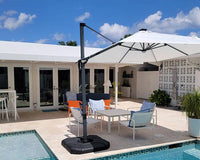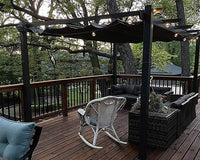It's common for water to pool under gazebos, which can make it hard to enjoy the outdoors and could even damage your structure. This piece talks about why keeping water from building up is important for making your gazebo last longer and be more comfortable to use. We'll talk about useful ways to keep the area dry, like making the gazebo better and improving drainage and landscape grades. You can keep your gazebo a nice place to relax all year by figuring out why water pools and fixing the problem.
Why Does Water Pool Under Your Gazebo?
Water pooling under your gazebo can result from a variety of factors, each contributing to potential damage and discomfort. One primary cause is poor drainage, often occurring when the surrounding ground cannot properly direct water away from the structure. This can lead to accumulation beneath the gazebo, especially during heavy rainfall. The uneven ground also plays a significant role, as low spots naturally collect water, exacerbating the problem.
When water consistently pools, it can compromise the integrity of the gazebo's materials. Wood structures may rot, metal components may rust, and even durable fabrics might suffer from mold and mildew. Beyond structural concerns, stagnant water becomes an ideal environment for pests like mosquitoes, which thrive in moist conditions.
How Can You Assess Your Gazebo Site?
Start by observing the area during or shortly after rainfall to identify where water tends to collect. Look for low spots and depressions near your gazebos that could lead to puddling. Using a long, straight board and a level, check if the ground slopes away from the gazebos; ideally, it should slope at least 2% (or about a 1/4 inch per foot) to encourage proper drainage.
Examine the soil type around the gazebo as well—compacted clay soils are less permeable and can worsen drainage issues, while sandy or loamy soils typically allow better water movement. Soil tests can help determine the composition and permeability of the ground.
Additionally, take note of any existing landscaping features, such as nearby hills, that might direct water toward your gazebo. By identifying these factors, you can develop a targeted approach to improving drainage and preventing water accumulation, ensuring your gazebo remains a dry and pleasant outdoor retreat.

What Are Effective Solutions for Keeping the Area Dry?
1. Improve Drainage
How Do French Drains Work, and How Can You Install Them?
The French drain is a useful way to move water away from your gazebo and keep it from pooling. It includes a sloped trench filled with dirt and a pipe with holes in it that moves water away from problem places.
To put in a French drain around your gazebo, you should first mark the path you want to use and make sure it goes away from the building. Dig a ditch that is 18 inches deep and 12 inches wide, making sure that the slope stays the same at about 1 inch every 10 feet. At the bottom of the trench, put down 2 inches of gravel. Then, put a punched PVC pipe on top of the gravel, with the holes facing down. Add more gravel to the trench until it's just below the surface. Then cover it with dirt or sod to match the rest of the yard's look.
Why Use Gravel or Sand Beds Beneath Your Gazebo?
Gravel or sand beds enhance drainage beneath your gazebo, promoting quick water runoff. Begin by clearing the area of grass and debris where the gazebo sits. Excavate to a depth of at least 4 inches, lay down the landscaper’s fabric to prevent weeds, and add 2-3 inches of gravel or coarse sand. Smooth it out evenly and use a tamper to compact the material, ensuring a stable base.
2. Adjust the Landscape
What Land Grading Techniques Redirect Water Efficiently?
Land grading reshapes the ground’s surface to direct water flow away from the gazebo. Ideally, the land should slope away at a rate of 2%, equivalent to a drop of 2 feet over 100 feet.
How Do Berms and Swales Improve Water Management?
Berms, which are raised mounds of earth and swales, shallow trenches, guide water away from structures. Place berms and swales strategically based on natural water flow patterns. To build berms, pile and shape the soil into gentle hills, compacting firmly to prevent erosion. For swales, dig shallow, V-shaped troughs along the contours of the land.

3. Enhance the Gazebo Structure
Should You Consider an Elevated Platform?
By building a raised base out of wood or plastic materials, you can raise your gazebo above the level of a possible flood. This method lowers the risk of standing water, improves the look, and makes the ground level. It can be expensive, though, and may need more upkeep.
When building a raised platform, you should plan a strong frame out of pressure-treated wood or composite materials that are firmly attached to the ground with concrete footings. Make sure the surface is level by putting deck boards close together so that water can drain.
Which Waterproof Flooring Options Are Best?
For flooring, choose materials like composite decking, treated wood, or interlocking tiles that resist moisture and require minimal maintenance. Measure accurately to ensure a precise fit and follow manufacturer instructions for installation. Regular cleaning and checking for signs of wear will help extend the lifespan of the flooring.
Preventative Measures to Keep Your Gazebo Dry
Develop the habit of cleaning the surroundings of the gazebo, including dirt, twigs, and trash from any drainage systems. This prevents blockages that could pool water from happening. Following heavy rain, make sure water is draining as it should and make any adjustments as needed.
Clear collected debris or sediment from drainage basins in spring and autumn. As melting could cause water buildup, avoid snow and ice build-up near the gazebo base in winter. Regular maintenance helps to reduce any damage and guarantees proper water flow.
A gutter system installed on the gazebo's roof effectively conducts rainfall away. Carefully position downspouts either securely away from the building or toward current drainage channels.
As a decorative alternative to traditional downspouts, you can consider using rain chains.They effectively direct water downwards and can be directed into suitable drainage solutions. To install rain chains, replace any existing downspouts with the chains and secure them at the roof edge to make sure they drain properly.
Both gutters and rain chains need to be checked regularly for damage or clogs, especially after storms.

Guarantee a Dry and Inviting Gazebo Space
Effective drainage solutions, landscape modification, and structural improvement of your gazebo will help to greatly lower water pooling problems. Strategic rainwater management—such as building gutters or rain chains—further shields your outdoor hideaway from any harm by regular maintenance. These efforts not only prolong the life of your gazebo but also improve comfort and usability all year long. Your gazebo will remain a dry, friendly place for leisure and pleasure in every season if you design and maintain it carefully.





1 comment
Hector Mendoza
I deeply regret and mad at myself for purchasing a Purple Leaf 12×16 Gazebo without a drainage system. Is there a way I can upgrade the roof edge by adding a gutter system?
Please let me know. Thank you.